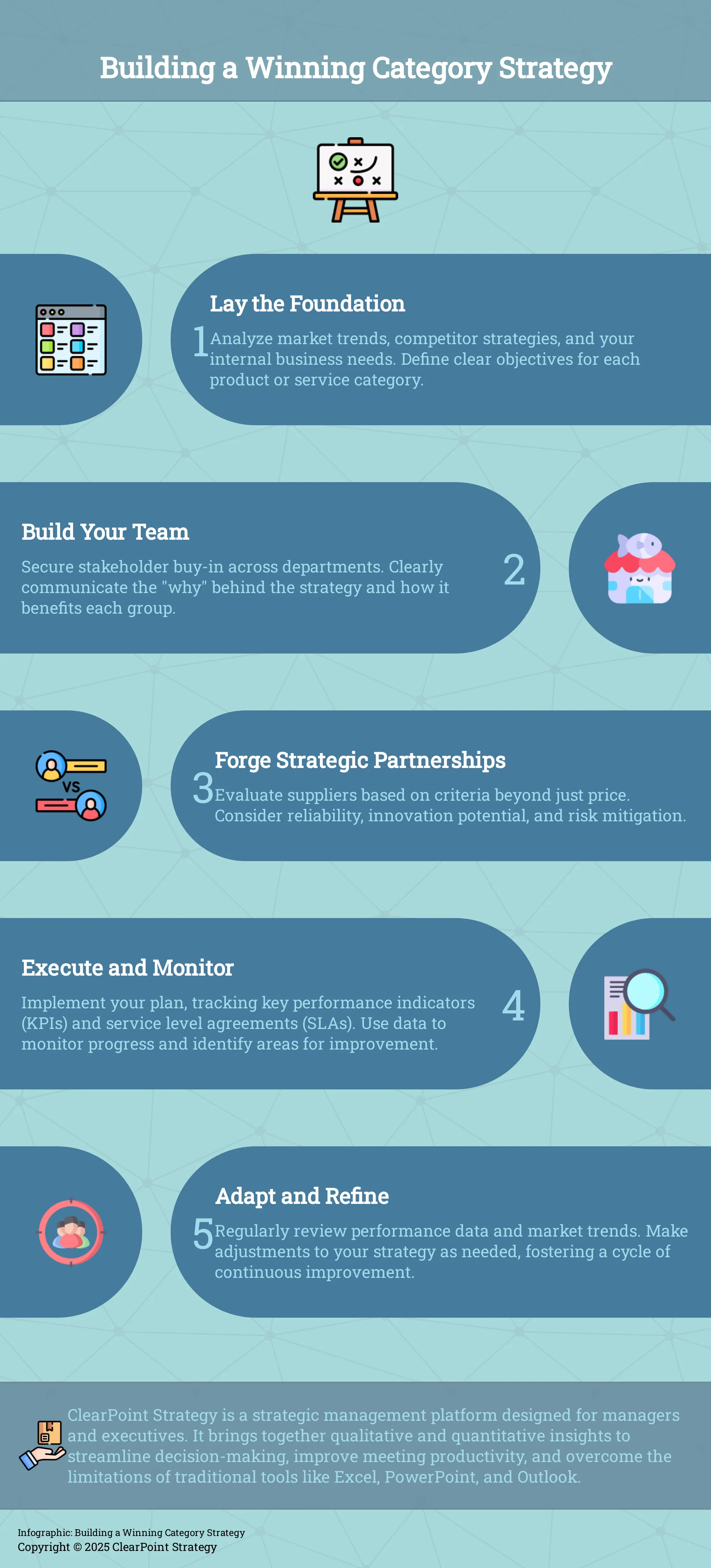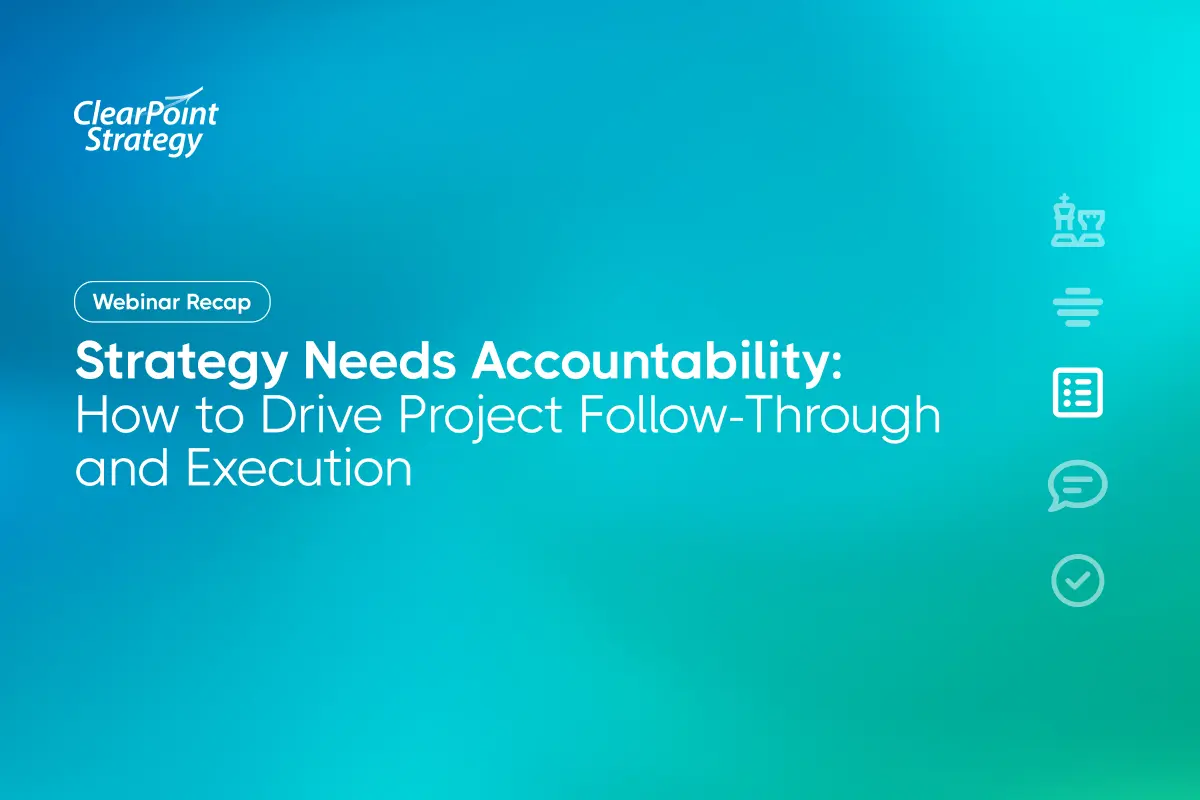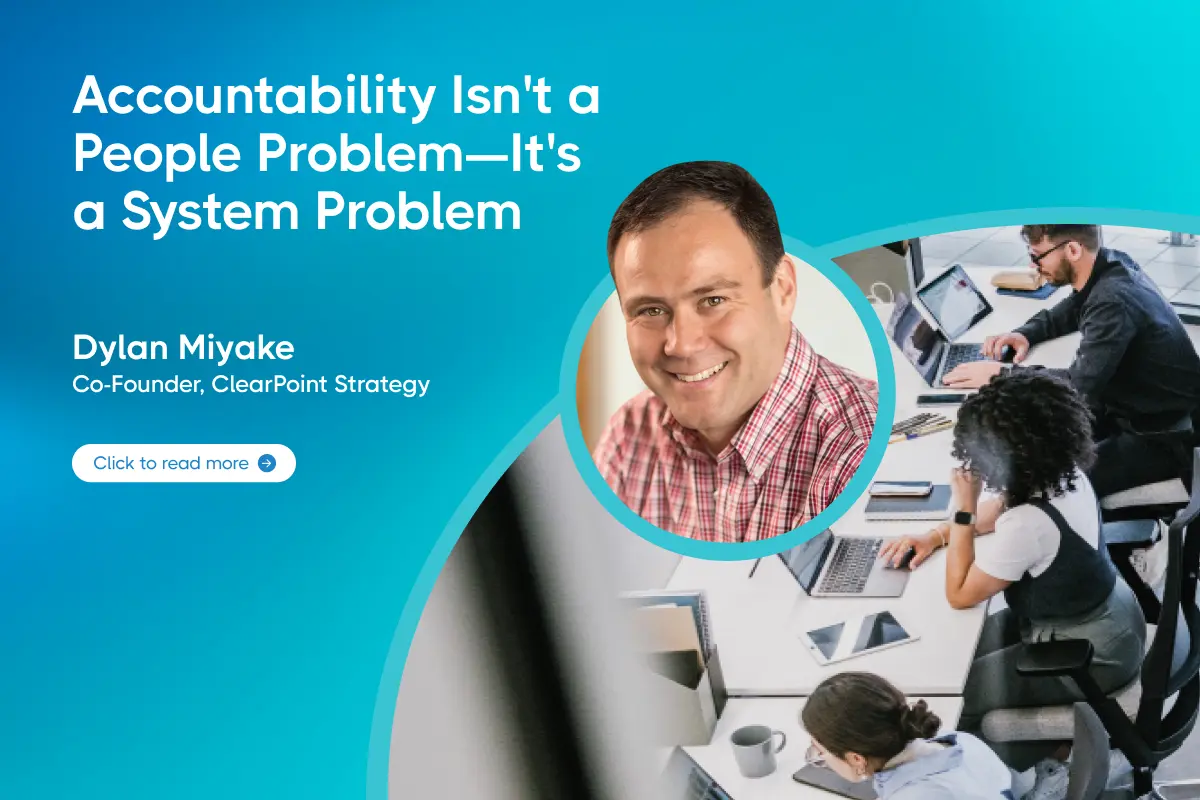Master category strategy implementation with this practical guide, offering actionable steps to optimize procurement and drive business growth.
What if you could improve your gross margins, build more innovative supplier partnerships, and gain a significant competitive edge, all by rethinking how you buy things? It sounds ambitious, but it’s the direct result of a well-executed category strategy. This isn't just another cost-cutting exercise; it's a fundamental shift in how you manage your supply chain and product mix. By treating each group of products or services as its own strategic unit, you unlock new opportunities for value. The process of category strategy implementation aligns your procurement and sales efforts with your company's overarching objectives, creating a powerful, unified engine for growth that delivers tangible benefits across the entire organization.
Key Takeaways
- Make Procurement a Strategic Advantage: Shift from reactive purchasing to a strategic function that aligns what you buy with your company’s core objectives. This approach creates a true competitive advantage by reducing risk and building stronger, more collaborative supplier partnerships.
- Embrace a Cycle of Continuous Improvement: A successful strategy is a living plan, not a static document. Establish a continuous loop of planning, executing, and monitoring performance with clear KPIs, using those insights to make smart adjustments that keep you aligned with the market.
- Align People and Data for Better Execution: The best strategies require both human alignment and reliable information. Overcome common roadblocks by involving stakeholders from the start, clearly communicating the "why" behind your plan, and using technology to create a single source of truth for data-driven decisions.
What Is Category Strategy (And Why Does It Matter)?
When we talk about business strategy, the conversation often gravitates toward high-level goals like market expansion or product innovation. While those are essential, I’ve found that true competitive advantage is frequently built on a more granular level. This is where category strategy comes in. It’s a focused, methodical approach that transforms how your organization buys and manages goods and services, moving you from a reactive, one-size-fits-all purchasing model to a proactive, strategic one. Think of it as the difference between simply stocking a warehouse and carefully curating a collection. A well-executed
A Simple Definition
So, what exactly is a category strategy? At its core, it’s a detailed plan for managing how your company sources a specific group—or "category"—of related products or services. Instead of treating every purchase the same, you analyze each category as its own strategic business unit. For example, a hospital wouldn't manage its surgical equipment purchases the same way it manages its office supplies. A category strategy formalizes this distinction, outlining a unique approach for sourcing, purchasing, and managing suppliers for each group. The goal is to optimize value, reduce risk, and build stronger, more collaborative supplier relationships that give your organization a distinct competitive edge.
The Real-World Benefits of a Strong Strategy
Implementing a category strategy goes far beyond simple cost-cutting. When done right, it delivers tangible benefits that ripple across the entire organization. For starters, it can directly improve your gross margins by enabling better negotiations with suppliers and minimizing losses from slow-moving inventory. But the advantages aren't just financial. A focused strategy helps you build deeper partnerships with key suppliers, which can enhance innovation and operational flexibility. When suppliers feel like true partners, they are more likely to share new technologies or work with you to solve complex challenges. Ultimately, this entire process is about delivering more value to your end customer, creating a win-win for everyone involved.
Which Industries See the Biggest Impact?
While any organization with significant procurement needs can benefit, some industries see a particularly dramatic impact from category strategy. In the fast-paced world of retail, for instance, fashion brands use it to align their product assortments with seasonal trends and regional tastes, ensuring the right products are on the shelves at the right time. For distributors, effective category management is often what separates the leaders from the laggards, especially as customer expectations for speed and availability continue to rise. We also see immense value in sectors like local government and healthcare, where managing vast and diverse categories of goods and services—from public works equipment to critical medical supplies—is fundamental to their mission.
The Core Components of a Winning Category Strategy
A truly effective category strategy is more than just a plan for buying things; it’s a comprehensive blueprint for creating a competitive advantage. Think of it as building a house. You wouldn't start laying bricks without a solid foundation and architectural plans. Similarly, a winning

Analyze Your Market and Business Needs
Before you can build a strategy, you need to understand the landscape. This starts with a deep analysis of both your external market and your internal business requirements. It’s about asking the right questions: What are the current trends in this category? Who are our main competitors, and what are they doing? And just as importantly, what does our organization need to achieve? A category plan is ultimately a tool to help the company save money, reduce risk, and build better relationships. This analysis isn’t a one-and-done task; it’s an ongoing process of listening to the market and aligning its opportunities with your strategic goals.
Align Your Stakeholders
A brilliant strategy that lives only in a document is worthless. Its real power comes from execution, and execution requires people. Getting buy-in from key stakeholders across your organization—from finance and operations to marketing and sales—is non-negotiable. Each department will have its own perspective and priorities, so your job as a category manager is to unite them around a shared vision. This involves clear communication about how the category strategy supports their individual goals and the company’s broader objectives. When everyone understands the "why" and feels a sense of ownership, you transform potential roadblocks into your biggest champions. This is the essence of effective stakeholder management.
Evaluate Suppliers and Manage Risk
Your suppliers are more than just vendors; they are critical partners in your success. Evaluating them goes far beyond a simple price comparison. You need to assess their reliability, quality, and capacity for innovation. At the same time, you must proactively manage risk. What happens if a key supplier faces a disruption? What are the biggest vulnerabilities in your supply chain? Creating a simple risk matrix that scores potential threats by their likelihood and impact can be incredibly revealing. This process helps you build a resilient network of partners who not only offer competitive terms but also contribute to your long-term stability and growth.
Optimize Your Product Mix and Pricing
This is where your strategy directly meets the customer. Optimizing your product or service mix means ensuring you’re offering the right things at the right price to maximize value. For a retailer, this might involve creating specific plans to generate excitement around a product line or improve the store’s overall image. For a B2B company, it could mean bundling services to better meet client needs. This component connects directly back to your initial market analysis. By understanding what customers want and what your competitors offer, you can strategically position your products to capture attention, drive sales, and strengthen your brand’s standing in the marketplace.
Use Technology and Data to Your Advantage
In today’s world, you can’t manage what you don’t measure. Relying on spreadsheets and manual tracking is no longer enough to maintain a competitive edge. Using the right technology is essential for turning your category strategy into a dynamic, data-driven operation. A robust platform allows you to track product assortments, manage supplier relationships, and access real-time performance data in one place. This gives you the clarity to see what’s working and what isn’t, enabling you to make swift, informed adjustments. Technology doesn’t replace strategic thinking, but it provides the AI-powered insights and clear reporting needed to execute your vision with confidence and precision.
How to Build and Launch Your Category Strategy: A 4-Step Guide
Turning a category strategy from a concept on a whiteboard into a real-world driver of business value is where the real work begins. It’s a process that requires careful planning, precise execution, and a commitment to ongoing refinement. Think of it less as a one-time project and more as a continuous cycle of improvement. At ClearPoint, we’ve seen countless organizations transform their operations by following a structured approach. Here’s a practical, four-step guide to help you build and launch a strategy that not only works but also evolves with your business.
Step 1: Plan and Prepare for Success
Before you can even think about suppliers or pricing, you have to do the foundational work. This first step is all about clarity and alignment. You need to clearly define what the business needs from each category. Is the goal to cut costs, mitigate supply chain risks, or drive innovation? Grouping your categories based on their strategic importance is a great way to start. More importantly, you must get your key stakeholders involved from day one. Their insights are invaluable, and their early buy-in will prevent roadblocks later. This initial planning phase sets the stage for everything that follows, creating a shared understanding of the "why" behind your strategy.
Step 2: Put Your Plan into Action
With a solid plan in place, it’s time to execute. A common mistake I see is focusing too heavily on finding the lowest price. While cost is always a factor, a truly effective category strategy looks for partners, not just vendors. You need to find suppliers who can meet all your business needs, from quality and reliability to innovation and scale. This requires a robust evaluation process based on the criteria you defined in the planning phase. This is where your strategy becomes tangible—in the relationships you build and the agreements you sign. It’s about making deliberate choices that support your long-term goals, not just your short-term budget.
Step 3: Monitor Performance and Make Adjustments
You can’t improve what you don’t measure. Once your strategy is live, you need a system to track its performance. This is where Key Performance Indicators (KPIs) and Service Level Agreements (SLAs) become your best friends. These metrics give you objective data on how well your strategy is working and where your suppliers are meeting—or missing—expectations. At ClearPoint, we believe that real-time performance tracking is non-negotiable for effective strategy execution. Regularly checking in on your categories ensures they remain aligned with your company’s goals. This isn’t about micromanaging; it’s about staying informed so you can make smart, timely adjustments.
Step 4: Create a Cycle of Continuous Improvement
The market is always changing, and your category strategy must be able to adapt. The final step is to build a culture of continuous improvement. This means actively encouraging new ideas and maintaining a flexible approach. Your strategy shouldn’t be a rigid document that gathers dust on a shelf; it should be a living framework that evolves. By creating a feedback loop where performance data from Step 3 informs new plans in Step 1, you transform a linear process into a powerful, self-improving cycle. This agility is what separates good strategies from great ones and ensures your organization remains competitive and resilient over the long haul.
How to Handle Common Roadblocks
Launching a new category strategy is rarely a straight line from A to B. It’s more like a road trip through new territory; you’ll encounter detours, traffic jams, and maybe a few surprise potholes. From my experience, the most successful leaders don’t just hope for a smooth ride—they anticipate these challenges and plan for them. Thinking of your strategy as a rigid, perfect plan is the first mistake. Instead, view it as a dynamic guide. The real measure of success isn't avoiding roadblocks, but in how skillfully you handle them when they appear.
At ClearPoint, we’ve seen that the most resilient strategies are built with flexibility in mind. Founders Ted Jackson and Dylan Miyake built our platform on the principle that strategy execution is an iterative process. It requires constant communication, data-informed adjustments, and a clear view of the entire landscape. The following roadblocks are not signs of failure; they are normal parts of the process. Here’s how you can prepare for them and keep your strategy moving forward.
Balance Competing Stakeholder Priorities
It’s a classic scenario: the finance team wants to cut costs, the marketing team wants to invest in premium branding, and the sales team is focused on volume. These competing priorities don’t mean your team is dysfunctional; it just means everyone is doing their job. The key is to bring these different perspectives into alignment before they become sources of friction. The biggest mistake is developing a strategy in a silo and then presenting it as a finished product. This can make stakeholders feel like they’re losing control or that their expertise has been ignored.
Instead, involve key stakeholders from the very beginning. Treat them as co-architects of the strategy. When people have a hand in building the plan, they are far more likely to support its execution. Using a centralized platform like ClearPoint Strategy creates a transparent environment where everyone can see the same goals and data, making it easier to have productive conversations and find common ground.
Get Ahead of Resistance to Change
Let’s be honest: most people are naturally resistant to change. It represents the unknown and disrupts comfortable routines. When you introduce a new category strategy, some team members may see it as an unnecessary complication or even a threat to their roles. To get ahead of this, you need to shift the narrative from "this is a change we have to make" to "this is an opportunity we can seize together." It’s crucial to communicate the “why” behind the strategy, focusing on the value it creates beyond simple cost-cutting.
Regular, open communication is your best tool here. Don’t just announce the strategy and disappear. Hold town halls, send regular updates, and create forums for questions and feedback. When people understand the vision and see how the new strategy benefits the entire organization—and their own work—they are more likely to become advocates rather than adversaries. This continuous dialogue helps build trust and ensures everyone remains aligned as the strategy unfolds.
Secure High-Quality, Accessible Data
A strategy without data is just an opinion. To make smart decisions, you need reliable information that answers critical questions about market trends, supplier performance, and internal costs. Yet, one of the most common hurdles I see is the struggle to get good data. It’s often locked away in different departmental silos, stored in incompatible formats, or simply incomplete. This not only slows down analysis but can lead to flawed conclusions that put your entire strategy at risk.
The goal is to create a single source of truth. This starts with identifying the key data points you need and then building the processes to collect and centralize them. According to a report in Harvard Business Review, a well-defined data strategy is essential for success. This is where technology becomes a powerful ally. Platforms like ClearPoint integrate with your existing systems to pull data into one place, turning a messy collection of spreadsheets into clear, actionable dashboards that everyone can access and understand.
Work Within Your Resource Limits
Grand strategic ambitions can quickly collide with the reality of limited resources. It’s easy to design a perfect plan on paper, but executing it requires real time, money, and people—all of which are finite. One of the most frequent missteps is underestimating the effort required for implementation. This leads to missed deadlines, budget overruns, and a burned-out team. A strategy that your team can’t realistically execute is not a useful strategy at all.
The most effective approach is to be ruthlessly realistic from the start. Break your ambitious strategy down into smaller, manageable phases. Prioritize initiatives that will deliver the biggest impact with the resources you have available. This creates a series of quick wins that build momentum and demonstrate the value of the strategy early on. Using strategy execution software helps you track progress and resource allocation in real time, so you can see if you’re on track and make adjustments before you go over budget or off schedule.
Adapt to a Shifting Market
The market doesn’t stand still, and neither should your strategy. A plan that was brilliant six months ago might be obsolete today due to a new competitor, a change in consumer behavior, or a global supply chain disruption. Treating your category strategy as a one-and-done document is a recipe for failure. The most resilient organizations build adaptability into the very fabric of their strategic process, allowing them to pivot when necessary. As an article in Forbes notes, an agile mindset is critical for navigating modern business challenges.
Think of your strategy not as a map with a single route, but as a GPS that constantly recalibrates based on current conditions. Schedule regular review cycles—quarterly or even monthly—to assess performance, challenge your assumptions, and scan the horizon for emerging trends. Real-time performance tracking is essential here. When you can see your KPIs move in response to market changes, you can make proactive adjustments instead of reactive repairs, ensuring your strategy remains relevant and effective.
How to Measure and Refine Your Strategy
Launching your category strategy is a major milestone, but it’s not the finish line. The most successful strategies are living documents—they breathe, adapt, and evolve with your business and the market. Think of your initial strategy as a well-researched hypothesis. Now, it’s time to test it in the real world, measure the results, and refine your approach based on what you learn. This continuous loop of measuring, analyzing, and adjusting is what separates a strategy that looks good on paper from one that delivers tangible, long-term value. It’s where the real work of execution happens, turning plans into performance. This ongoing refinement process ensures your strategy doesn't just sit on a shelf; it actively works for you, guiding your team toward its most important goals with the clarity of a GPS.
Define the Right KPIs to Track Success
You can’t manage what you don’t measure. To understand if your strategy is working, you need to define the right Key Performance Indicators (KPIs). These are the vital signs of your category’s health, giving you a clear, objective look at your progress. Your KPIs should connect directly to your strategic goals. If a primary objective is cost reduction, you’ll want to track metrics like savings per unit or total cost of ownership. If you’re focused on innovation, you might measure the number of new products launched from a key supplier. The key is to choose a handful of metrics that truly matter rather than drowning in a sea of data. These indicators act as your guideposts, ensuring your team stays focused on achieving the intended outcomes.
Use the Right Tools for Tracking and Analysis
Gone are the days of wrestling with scattered spreadsheets to understand performance. To effectively track your KPIs, you need a centralized system that provides a single source of truth. This is where technology becomes your greatest ally. A robust strategy execution platform automates data collection and visualizes your progress in real-time dashboards. Instead of spending hours compiling reports, you can see at a glance how your categories are performing against their targets. This allows you to shift your time from data wrangling to strategic analysis, identifying trends and spotting potential issues before they become major problems. Having the right tools gives you the clarity and confidence to make informed decisions quickly.
Adopt Best Practices for Ongoing Improvement
A category strategy is not a one-and-done project; it’s a cycle of continuous improvement. The market is always changing, and your strategy must be agile enough to adapt. To build this agility, establish a regular cadence for reviewing performance. This could be a monthly KPI check-in or a more in-depth quarterly strategy review. These meetings create a dedicated time to discuss what the data is telling you, celebrate wins, and collaboratively problem-solve challenges. By embedding this review process into your team’s routine, you foster a culture where ongoing improvement is the norm. It ensures your strategy remains relevant and responsive to shifting customer needs and market dynamics.
Turn Your Results into Strategic Adjustments
Collecting data and tracking KPIs is only half the battle. The real value comes from using those insights to make smart, strategic adjustments. When a KPI is off track, it’s an opportunity to ask why and explore the root cause. Does a supplier consistently miss delivery targets? It might be time to renegotiate terms or explore alternatives. Is a new product line underperforming? Perhaps the pricing or marketing strategy needs a second look. This is the essence of data-driven decision-making. By using performance data to inform your choices, you can pivot with purpose, refine your approach, and continuously enhance the effectiveness of your category strategy.
Related Articles
- Understanding the Three Levels of Business Strategy for Success
- Business vs. Corporate Strategy: Key Differences Explained
- Strategy vs. Tactics: Differences, Examples & How to Track Both
- How to Write a Business Strategy Report: A Step-by-Step Guide
Frequently Asked Questions
How is a category strategy different from just good procurement? That’s a great question because it gets to the heart of the matter. Think of traditional procurement as being very transaction-focused—it’s about buying the right things at the best price for today's needs. A category strategy elevates this by taking a long-term, holistic view. Instead of just buying, you're managing an entire category of goods or services as if it were its own small business unit, aligning every decision with the company's overarching strategic goals, from risk management to innovation.
We're a smaller organization. Is this approach still practical for us? Absolutely. While large corporations with massive procurement departments often champion category strategy, the principles are universal. For a smaller business, it might mean focusing on just a few critical categories that have the biggest impact on your costs or customer experience. The goal is the same: to be more intentional about your spending and supplier relationships. You don't need a huge team, just a focused approach to managing your most important purchasing areas strategically.
What's the most common mistake you see when companies first try to implement a category strategy? The most frequent misstep I see is developing the strategy in isolation. A team will do incredible research and create a brilliant plan, but they forget to bring key stakeholders from other departments along for the ride. When the plan is finally revealed, it’s met with resistance because people feel like a change is being forced upon them. True success comes from making it a collaborative process from the very beginning.
How do you get buy-in from different departments that all have their own priorities? This is the classic challenge, but it's solvable. The key is to frame the category strategy in terms of a shared victory. Instead of presenting it as a procurement initiative, show each department how it directly supports their goals. For finance, it’s about improving margins. For marketing, it might be about ensuring brand consistency through better suppliers. When you connect the strategy to what they already care about, you transform them from stakeholders into partners.
How often should we be reviewing and adjusting our category strategy? A category strategy should never be a "set it and forget it" document. The market moves too fast for that. I recommend a formal, in-depth review at least once a year, but you should be checking in on your key performance indicators on a monthly or quarterly basis. This allows you to make small, proactive adjustments based on real-time data rather than waiting for a problem to become a crisis. It keeps your strategy agile and responsive.

.svg)




